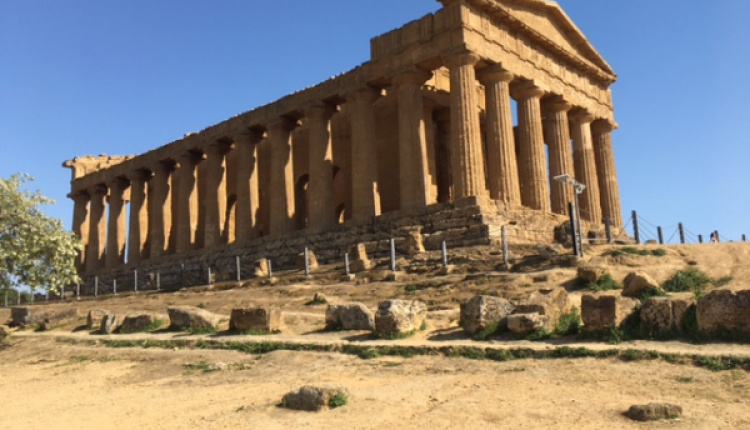Ancient Frieze From Zeus Temple Found Near Shore
- by XpatAthens
- Monday, 12 February 2024

Marine archaeologists were left astounded when their eyes fell upon a massive piece that, at first glance, appeared to be crafted from marble, only to reveal itself as something altogether unexpected. Employing meticulous photogrammetric techniques for examination and verification, they discerned that they had stumbled upon a segment of a frieze originating from an ancient temple.
The meticulousness of their research cannot be overstated. Plunging into the depths off the coast of Sicily, the discovery of an ancient frieze was certainly within the realm of possibility. Remarkably, the marble block lay merely 9 meters beneath the surface, unveiling a treasure trove of historical significance. Expert analysis swiftly attributed the frieze to the renowned Temple of Zeus in ancient Akraganta, situated near the coast of San Leone, not far from the Akraganta River's mouth.
The Temple of Zeus stands as a monumental testament to ancient Doric architecture, nestled within the revered Valley of the Temples. This sacred site, synonymous with the splendor of ancient Akraganta, boasts an array of iconic structures, including the Temple of Concordia, the Temple of Juno, the Temple of Hercules, and others. Among these, the Temple of Zeus reigns supreme in grandeur, stretching an imposing 112 meters in length and 56 meters in width. Historical chronicles, notably those penned by the ancient Greek historian Diodorus Siculus, recount the temple's tumultuous history, including its unfortunate halt in construction following the Carthaginian conquest in 406 BC.
Tragically, the temple's fate was sealed by seismic upheavals and the rampant quarrying of the 18th century, as locals scavenged its noble stones for the construction of nearby settlements. Yet, amidst the ruins and ravages of time, a glimmer of hope emerged beneath the waves.
In a stroke of serendipity, underwater archaeologists, under the auspices of BCsicilia, unearthed the marble relic approximately 300 meters from the coastline, its shallow resting place obscured by the sedimentary embrace of the Akraganta River. Measuring an impressive 2 meters in length and 1.6 meters in height, the frieze is hewn from Prokonnisian marble sourced from the storied quarries of Prokonnisos, the largest of the Marmara Islands in Turkey.
Adorning one side of the frieze is a masterfully carved depiction of a vaulting horse, likely an ornamental flourish adorning the outer façade of the temple's drum, or perhaps gracing the pediment's lofty pinnacle, encircled by an ornate cornice. Horses, emblematic of martial prowess and political authority, were recurrent motifs in the artistic lexicon of ancient Greek architecture.
BCsicilia, a devoted custodian of Sicily's cultural and environmental heritage, promptly apprised the Marine Inspectorate of their extraordinary find, initiating a coordinated effort to recover this priceless artifact. In a collaborative endeavor involving the Carabinieri Diving Unit, the Marine Inspectorate, the Carabinieri Cultural Heritage Protection Unit, and BCsicilia's underwater team, the frieze was successfully retrieved and brought ashore on the morning of February 5th, 2024.
BCsicilia, as a voluntary cultural organization dedicated to safeguarding and promoting Sicily's rich cultural and natural legacy, stands as the vanguard of such endeavors, providing invaluable insights into our collective past.
Originally published in Greek, on: enikos.gr
Originally published in Greek, on: enikos.gr


